As Eric noted on Monday, March was a remarkable month this year for how warm it was in Houston. But it was not quite like March 1907, which will remain atop the leaderboard for warmest March in Houston’s recorded history.
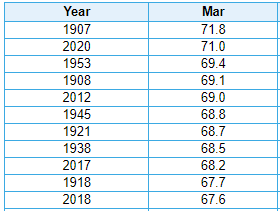
Although we are in a warming climate, where warm records have tended to outnumber cold records by a 2:1 margin in recent years, when you look back at history, you will occasionally find some random, weird anomalous events. The month of March in 1907 ranks among them.
Houston in March 1907
Cast your mind back more than a century ago. In 1907 Houston was but a town, with roughly 60,000 residents. Whereas today Houston is the fourth largest city in the United States, it was nowhere near the top 10 rankings of most populated cities of that era.
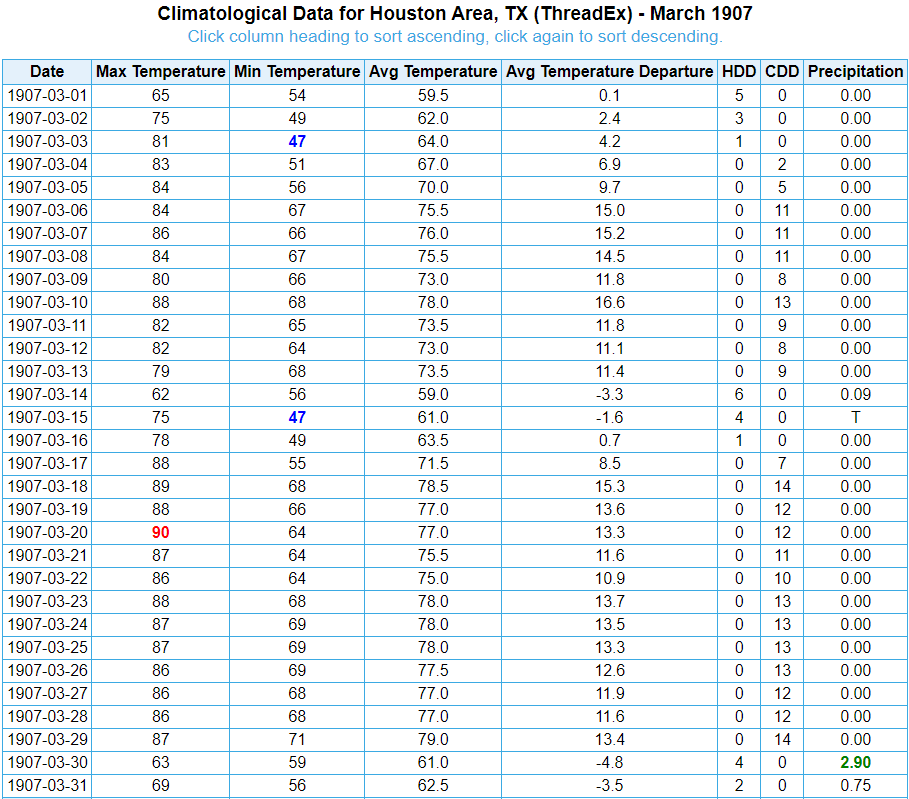
There was little about March 1907 that was cool in Houston. More than half of the month (16 days) saw low temperatures of 65° or warmer, a record for any March. Over the last 10 years, in a warm climate, in a much more robustly developed Houston, we have only averaged 6 to 7 mornings that warm in March. This year’s March is the closest to rival that since 1955, matching that year’s 14 days of not dropping below 65 degrees.
Houston only had one 90 degree day in March 1907, but the city recorded 15 days above 85 degrees that year, which is far and away the record for any March. The next closest are 1908 and 2017 when we accomplished that feat a mere 8 times. This year’s March only saw 5 days above 85 degrees.
You would think that we’d find some details on how people felt about the abnormal weather from local newspapers at the time. In Houston at least, it was not discussed much in the papers. Weather was not the front page headline it often is today. There were a couple passing references to fine or warm weather but little substance beyond that. However, there was one piece of news: Houston’s dog catcher at the time, Herr Lutzelberger, announced operations to catch stray dogs would begin early because of the warm weather.

Any dogs found without their city dog tax license would be, well, killed by … making them drink too much water? According to the Houston Chronicle on March 20, 1907, “Herr Lutzelberger is getting his lassoo (sic) ready and the dog wagon has been doctored up a bit, and now the paraphernalia of catching unlegalized dogs is all ready for the work.” As far as we know, Herr Lutzelberger is no relative to Eric Berger, who would write for the Chronicle a century later.
Meteorology of March 1907
So what happened, meteorologically, to allow this to happen? We obviously have limited data from that time period, but thankfully we have NOAA’s 20th century reanalysis which should at least give us a good idea of what things probably looked like. If you take the entire month of March and look at the upper air pattern (the 500 mb pattern for those more meteorologically inclined), you see a couple pretty obvious signals.
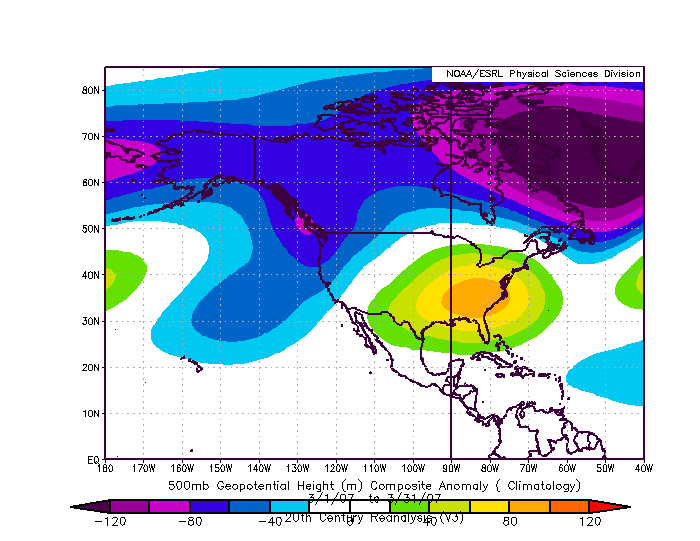
We are looking at upper air anomalies here, not the actual 500 mb pattern, but it’s obvious that there’s a strong signal for above normal heights (warmer weather) in the Eastern U.S. during the month. You can also see a large, strong area of below normal heights over Greenland, indicative of what we’d call the positive phase of the North Atlantic Oscillation (NAO). Going back to 1865, that year saw one of the most positive NAO values on record, ranking 7th highest out of 155 years. Typically a +NAO correlates to a warmer Eastern U.S. in winter or early spring. You need more than just that, however. March 1994 had the highest NAO value in that dataset, and it ended up an “average” month in Houston and many other places in the Eastern U.S.
It appears from the map above that we also managed to be helped by a Pacific pattern that would also have been favorable for warmer weather in Texas and the Eastern U.S., while folks out West were a bit cooler.
Editor’s Note: I’ll try to post a composite of March 2020 here for comparison’s sake once the data is compiled, which should be April 2nd or 3rd.
Let’s just focus on the back half of March. The animation below shows the 500 mb heights (not anomalies) day by day from March 15 to March 31, 1907.
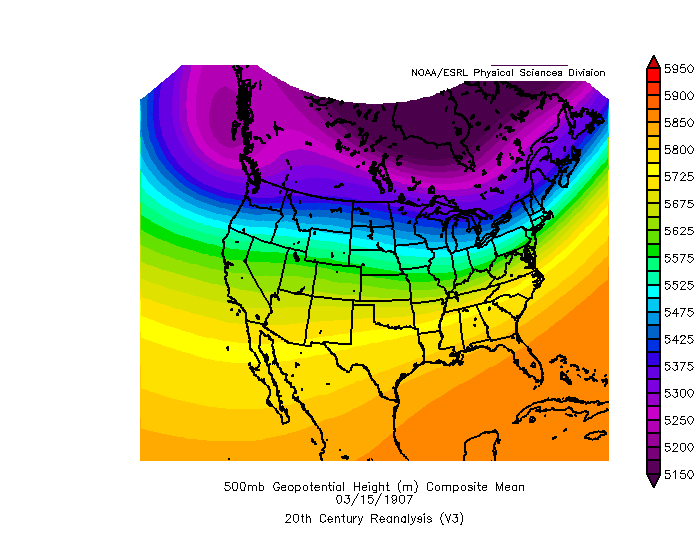
You can see how an Eastern U.S. ridge established, strengthened, and held on for dear life through almost the entire back half of March that year. Some records from this period still stand today. Record highs in Houston March 20 and 21 (90 and 87 degrees, respectively) remain. Any other warm records have long since disappeared with a significant urban heat island effect and a warming climate.
Elsewhere
The year 1907 was not just a Houston phenomenon. Washington, DC has only hit 90 degrees three times in March. All three occurrences were in 1907. The Washington Times reported on the heat on March 23rd that year, saying the 90 degree days “will go down in history as the best examples of what can but should not be.”
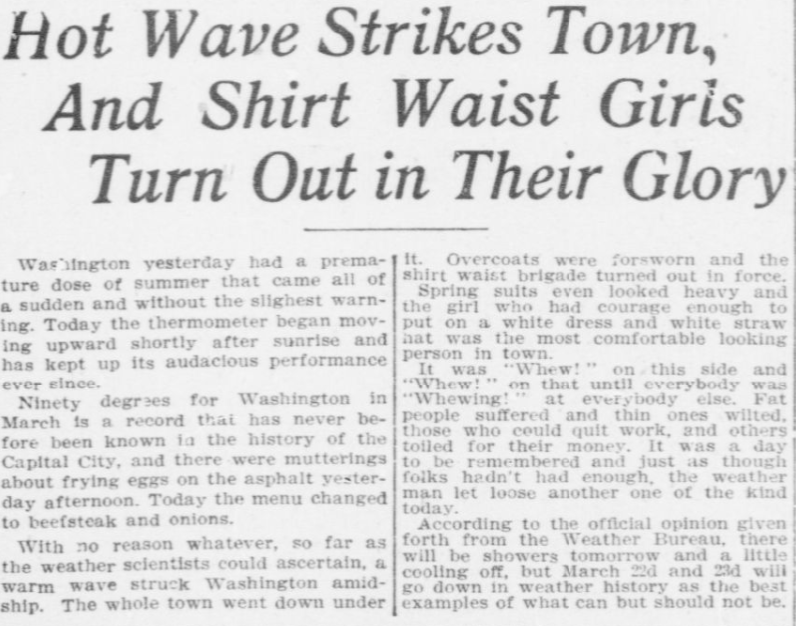
Elsewhere, the heat brought people outside in droves. Atlanta parks “drew almost a July crowd on Sunday (March 24th)” when the city topped off at 83 degrees, after hitting 87 degrees the previous two days. The 87 degrees reached on March 22nd still stands as a record high in Atlanta. The Atlanta Georgian and News described it well: “All nature seems bent on hurrying the summer before winter has turned the curve in the road to the past. There’s something in the atmosphere that fairly makes you ache to get out in the open woods and camp there.” March 1907 is the 4th warmest March on record in Atlanta.
St. Louis hit 90 degrees on Thursday, March 21st, a record that still stands. According to the St. Louis Post-Dispatch, that was the hottest March temperature on record, going back 71 years from that time.
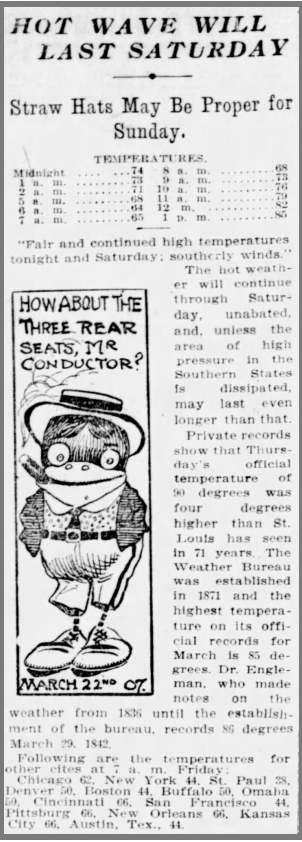
On March 29, 1842, St. Louis apparently hit the original March record of 86 degrees. Obviously, records that far back are to be taken with a grain of salt. Still, that nothing really rivaled March heat that significant for 65 years is impressive.
In Louisville, March 22, 1907 remains the record for warmest March day in their history when they topped out at 88 degrees at 2 pm.
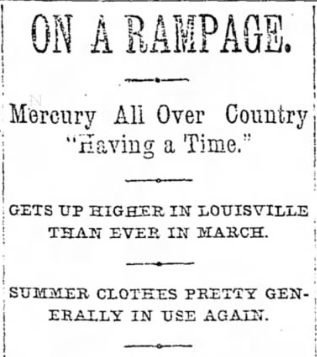
The Louisville Courier-Journal explained that “summer garb was everywhere in evidence yesterday. Overcoats were discarded several days ago, and yesterday men appeared without vests on the street.” Summer clothes were brought out and most homes threw open their doors and windows.
Chicago rose to 80 degrees on March 23, 1907, still a record for the date and the hottest March reading on record at that time. “During the heated portion of the day, gentle spring zephyrs saved people in the downtown district from feeling any ill effects from the heat,” reported the Chicago Tribune.

Lest you believe that a hot March means the rest of spring is guaranteed to be hot. Dallas has two record lows from May of 1907 that still stand today. St. Louis has one from April and one from May.
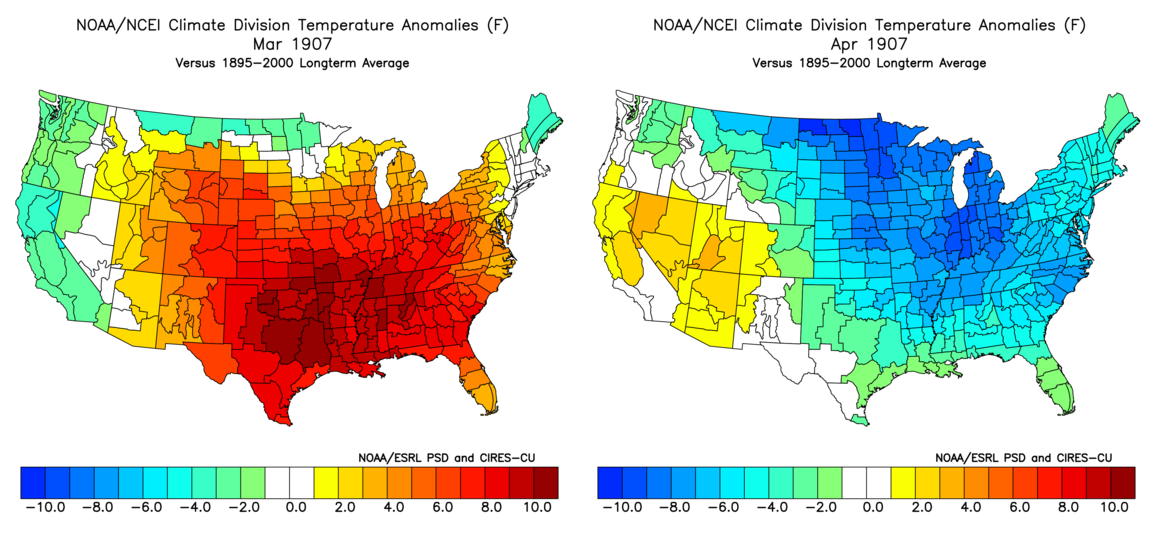
We flipped from about 10 degrees above normal (vs. an 1895-2000 average) in March to about 2 or 3 degrees below normal in April here in Houston. St. Louis went from about 7 or 8 degrees above normal in March to about 6 or 7 degrees below normal in April. May was not much warmer relative to average that year. Nothing is ever guaranteed.
March 1907’s warmth probably would not rank as an extraordinary weather event if it occurred today, but at the time, it was a rather stunning event for a very large chunk of the country to experience. March 2020 certainly was impressive here in Houston locally, but even it could not outrank the powerhouse March of 1907.

Drowning is the expected method I believe.
Matt,
In this article there is a 500mb height animation for your extreme year of 1907. A quick internet check states the first US Weather Bureau radiosonde was launched on January 7, 1929. So back in 1907, the 500mb mandatory pressure level wasn’t even “a thing.” How were these 1907 500mb heights deduced?!
NOAA undertook a pretty serious long-term project to “reconstruct” data the early 20th century and even 19th century. They’ve been modifying and improving it since. As I noted in the post, while the maps shown are imperfect, they likely are fairly close to what you would have expected to see, given the conditions. And in this case, some of the things shown here would have added up to an impressively warm month. So it’s not something you’d take 100% literally, but it’s as good as we can do and it’s likely a pretty good representation of what reality looked like at that time.
I love the old newspaper snippets!
“…the water route to dog heaven.” = Drowning
Thanks Matt. Well…I guess global warming started a little earlier than thought which is good because this should give today’s global warming crowd something to compare to more than a century ago. Of course…they will have to add in increased CO2, more concrete and…oddly enough…increased emissions of cattle farts. I’m also guessing PETA wasn’t a well known organization back then either. Thanks for the post guys.
As I note in the post, there are always going to be anomalous events from way back when. That’s just the law of averages. Reality is that things are much warmer now, and as I point out in the post, a 1907 happening today would not raise as many eyebrows as it did then, given that so many recent March months have been so warm nationally. A few records from 1907 have remained and stood the test of time, which further underscores just how anomalous 1907 was. But one month in one year certainly doesn’t challenge current scientific theories.
Point well said. My meteorological and science knowledge pales in comparison to you two…no doubt. I do agree that some global warming theories are a little far fetched. This said…you can’t argue hard data. I always enjoy reading you guys forecasts and explanations as they are the best around. Thanks again 👍
Thanks guys for the history lesson. I always enjoy the comments on SPW and the cast of regular characters and their funny comments – “cattle farts?” Indeed! I needed a good laugh.
When I saw the earlier references to the March 1907 highs on this site, I wondered how accurate the data was. But after reading this, it seems like the weather – both in Texas and nationwide – was pretty well documented.
I still do wonder how many old highs and lows are trustworthy; how much trust can we put in weather stats from 60 or 70+ years ago? Does more recent meteorology ever discount past statistics?
There has been a lot of work to “thread” together temperature records in a bunch of locations that have long-term data. The official thermometer may move from one part of a city to another, and NOAA has done work to thread all those movements together into a continuous history of temperatures. Overall, it’s pretty good. I wouldn’t make a lot of decisions today based on data from 100-125 years ago, but I would definitely utilize it to find extremes. And I think that has been done. When I make seasonal outlooks, I only use data post-1950, when it was more reliable. But I have looked at pre-1950 data sometimes to get a sense of goalposts.
Interesting post. Highly enjoyed it. My grandfather was born in 1908. Just missed it by one year.
Interesting post! And excellent job with the research into multiple old newspapers.
Well the sky is surely falling… It was hot 100 years ago and it’s hot today. Except 100 years ago they made a few jokes about it and moved on. Now you can’t miss an opportunity to talk about how it’s a “cLiMaTe cRiSiS”. It was hot between the last couple of ice ages, too – what kind of cars did the dinosaurs drive?
You might want to reread the post. It seems like you misunderstood what Matt was saying. Warming today is a long running trend, not just one anomoly, but a continuous chain of anomolies. That’s why scientists, meteorologists, and the writers of this blog all agree that we are experiencing unprecedented global warming. The 1907 March warmth was a singular anomoly and not part of a trend, which is why at the time it was not seen as anything more than a hot month. The difference here is “one really hot month (March 1907)” vs “continuously warmer than average months trending hotter with time (the past century)”
Love this kind of history. Thanks!